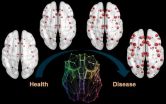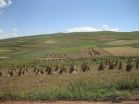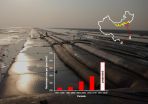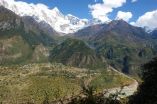An Ebola virus protein can cause massive inflammation and leaky blood vessels
2014-11-20
(Press-News.org) Ebola GP protein covers the virus' surface and is shed from infected cells during infection. A study published on November 20th in PLOS Pathogens reports that shed GP can trigger massive dysregulation of the immune response and affect the permeability of blood vessels
Ebola virus has seven genes. One of them, called GP, codes for two related proteins: a shorter secreted one and a longer one that spans the viral wall and sticks out of its surface. During virus infection, some of the surface GP is cut off by a human enzyme and is subsequently shed from infected cells. High levels of both shed and secreted GP are found in the blood of infected humans and animals.
Rather than working with intact Ebola virus, Viktor Volchkov and colleagues from the Claude Bernard University of Lyon, International Center for Infectiology Research (CIRI), INSERM, France, produced shed and secreted GP in tissue culture and used these proteins to test their effects on human cells.
They found that shed but not secreted GP can bind to immune cells, called macrophages and dendritic cells, both also targets of Ebola virus infection. Upon binding of shed GP, these immune cells start releasing massive quantities of immune-modulators. Both shed GP and these immune-modulators are soluble proteins that can travel in the blood stream, and this might explain how through continuing production and release of shed GP an initial immune response to the virus gets amplified and can spiral out of control, leading to high fever, massive inflammation, and possibly the shock that kills many Ebola patients.
The scientists also found that the effects of shed GP on the immune cells depends on a molecule called TLR-4. Blocking TLR-4 with specific antibodies prior to exposing immune cells to shed GP damped the cells' reaction and eliminated much of the release of immune modulators.
Besides massive and destructive inflammation, fatal Ebola disease is also associated with loss of blood vessel integrity--hence the name Ebola hemorrhagic fever. To examine a possible contribution of GP to these symptoms, the researchers examined the effects of secreted and shed GP on permeability of endothelial cells (which form blood vessels). They found that shed GP directly--as well as through the cocktail of immune-modulators produced by immune cells upon binding of shed GP--can increase permeability of endothelial cells.
While the results of the study need to be confirmed in the context of infected animals or humans, the authors conclude that their data "support a role for EBOV shed GP in the creation of excessive and dysregulated host inflammatory responses and an increased vascular permeability". They also speculate that "anti-TLR4 antibodies could be used to reduce the inflammatory reaction caused by shed GP".
INFORMATION:
Contact:
Viktor Volchkov
e-mail: viktor.volchkov@inserm.fr
phone: +33.4.37.28.24.50
Please use this URL to provide readers access to the paper (Link goes live upon article publication):
http://dx.plos.org/10.1371/journal.ppat.1004509
Authors and Affiliations:
Beatriz Escudero-Pérez,
Valentina A. Volchkova,
Olga Dolnik,
Philip Lawrence,
Viktor E. Volchkov
All authors are affiliated with INSERM U1111- CNRS UMR5308, Université de Lyon, France
Please contact plospathogens@plos.org if you would like more information.
Funding: This work was supported by the European Union FP7 project ANTIGONE (278976), Agence Nationale de la Recherche (ANR-07-MIME-006-01), Fondation pour la Recherche Medicale (DMI20091117323), the Direction Generale de l'Armement (DGA) and « La Caixa » Fondation. The funders had no role in study design, data collection and analysis, decision to publish, or preparation of the manuscript.
Competing Interests: The authors have declared that no competing interests exist.
Citation: Escudero-Pérez B, Volchkova VA, Dolnik O, Lawrence P, Volchkov VE (2014) Shed GP of Ebola Virus Triggers Immune Activation and Increased Vascular Permeability. PLoS Pathog 10(11): e1004509. doi:10.1371/journal.ppat.1004509
[Attachments] See images for this press release:

ELSE PRESS RELEASES FROM THIS DATE:
2014-11-20
Researchers from the Montreal Neurological Institute have used a model inspired by patterns of epidemic disease spreading to map how misfolded proteins propagate within the brain.
Proteins which fail to configure correctly (misfolded proteins) are associated with aging and several human neurodegenerative diseases, such as Alzheimer's. In research published in this week's PLOS Computational Biology, Yasser Iturria Medina and colleagues analyze over 700 individual Amyloid-beta proteins imaging datasets to conclude that the propagation of these misfolded proteins, associated ...
2014-11-20
An international team of researchers has shown that it may be possible to improve the effectiveness of the seasonal flu vaccine by 'pre-empting' the evolution of the influenza virus.
In a study published today in the journal Science, the researchers, led by the University of Cambridge, describe how an immunological phenomenon they refer to as a 'back boost' suggests that it may be better to pre-emptively vaccinate against likely future strains than to use a strain already circulating in the human population.
Influenza is a notoriously difficult virus against which to ...
2014-11-20
RIVERSIDE, Calif. - Yellow fever is a disease that can result in symptoms ranging from fever to severe liver damage. Found in South America and sub-Saharan Africa, each year the disease results in 200,000 new cases and kills 30,000 people. About 900 million people are at risk of contracting the disease.
Now a research team led by a biomedical scientist at the University of California, Riverside has determined that the yellow fever virus, a hemorrhagic fever virus, replicates primarily in the liver. Therefore, other organ failures that often follow in people with the ...
2014-11-20
During the development of mammals, the growth and organization of digits are orchestrated by Hox genes, which are activated very early in precise regions of the embryo. These "architect genes" are themselves regulated by a large piece of adjacent DNA. A study led by Denis Duboule, professor at the University of Geneva (UNIGE) and the Federal Institute of Technology in Lausanne (EPFL), Switzerland, reveals that this same DNA regulatory sequence also controls the architect genes during the development of the external genitals. The results published in Science magazine, indicate ...
2014-11-20
If you are an active senior who wants to stay younger, keep on running.
A new study involving the University of Colorado Boulder and Humboldt State University shows that senior citizens who run several times a week for exercise expend about the same amount of energy walking as a typical 20-year-old.
But older people who walk for exercise rather than jog expend about the same amount of energy walking as older, sedentary adults, and expend up to 22 percent more energy walking than the 20-something crowd. The study, led by Humboldt State Professor Justus Ortega, was published ...
2014-11-20
Animal teeth, bones and plant remains have helped researchers from Cambridge, China and America to pinpoint a date for what could be the earliest sustained human habitation at high altitude.
Archaeological discoveries from the 'roof of the world' on the Tibetan Plateau indicate that from 3,600 years ago, crop growing and the raising of livestock was taking place year-round at hitherto unprecedented altitudes.
The findings, published today in Science, demonstrate that across 53 archaeological sites spanning 800 miles, there is evidence of sustained farming and human ...
2014-11-20
China's second great wall, a vast seawall covering more than half of the country's mainland coastline, is a foundation for financial gain - and also a dyke holding a swelling rush of ecological woes.
A group of international sustainability scholars, including Jianguo "Jack" Liu, director of Michigan State University's Center for Systems Integration and Sustainability, in a paper published today in Science magazine, outline the sweeping downsides of one of China's efforts to fuel its booming economy, downsides that extend beyond China.
China's coastal regions are only ...
2014-11-20
The Himalaya features some of the most impressive gorges on Earth that have been formed by rivers. The geologic history of the famous Tsangpo Gorge, in the eastern Himalaya, now needs to be rewritten.
A team of German, Chinese, and American geoscientists have namely discovered a canyon, filled with more than 500 m of sediments beneath the bed of the present-day Yarlung Tsangpo River upstream from the gorge. Using drill cores, the scientists were able to reconstruct the former valley floor of this river, which allowed them to reconstruct the geological history of the Tsangpo ...
2014-11-20
Doctors have long been mystified as to why HIV-1 rapidly sickens some individuals, while in others the virus has difficulties gaining a foothold. Now, a study of genetic variation in HIV-1 and in the cells it infects reported by University of Minnesota researchers in this week's issue of PLOS Genetics has uncovered a chink in HIV-1's armor that may, at least in part, explain the puzzling difference -- and potentially open the door to new treatments.
HIV-1 harms people by invading immune system cells known as T lymphocytes, hijacking their molecular machinery to make more ...
2014-11-20
A team of researchers from Caltech and the China Earthquake Administration has discovered an ancient, deep canyon buried along the Yarlung Tsangpo River in south Tibet, north of the eastern end of the Himalayas. The geologists say that the ancient canyon--thousands of feet deep in places--effectively rules out a popular model used to explain how the massive and picturesque gorges of the Himalayas became so steep, so fast.
"I was extremely surprised when my colleagues, Jing Liu-Zeng and Dirk Scherler, showed me the evidence for this canyon in southern Tibet," says Jean-Philippe ...
LAST 30 PRESS RELEASES:
[Press-News.org] An Ebola virus protein can cause massive inflammation and leaky blood vessels






